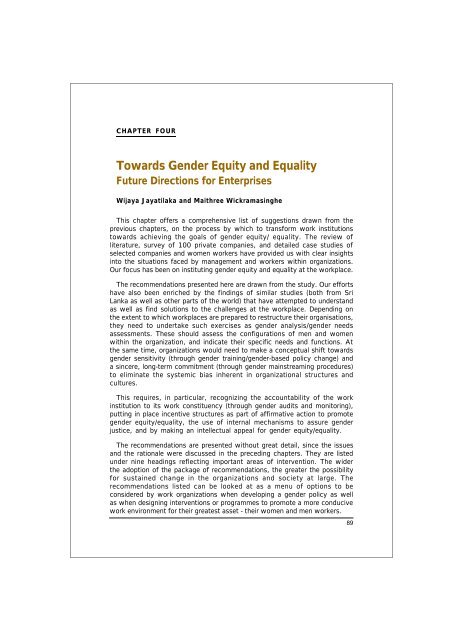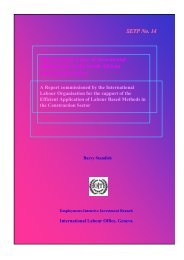Beyond Glass Ceilings and Brick Walls - International Labour ...
Beyond Glass Ceilings and Brick Walls - International Labour ...
Beyond Glass Ceilings and Brick Walls - International Labour ...
Create successful ePaper yourself
Turn your PDF publications into a flip-book with our unique Google optimized e-Paper software.
CHAPTER FOUR<br />
Towards Gender Equity <strong>and</strong> Equality<br />
Future Directions for Enterprises<br />
Wijaya Jayatilaka <strong>and</strong> Maithree Wickramasinghe<br />
This chapter offers a comprehensive list of suggestions drawn from the<br />
previous chapters, on the process by which to transform work institutions<br />
towards achieving the goals of gender equity/ equality. The review of<br />
literature, survey of 100 private companies, <strong>and</strong> detailed case studies of<br />
selected companies <strong>and</strong> women workers have provided us with clear insights<br />
into the situations faced by management <strong>and</strong> workers within organizations.<br />
Our focus has been on instituting gender equity <strong>and</strong> equality at the workplace.<br />
The recommendations presented here are drawn from the study. Our efforts<br />
have also been enriched by the findings of similar studies (both from Sri<br />
Lanka as well as other parts of the world) that have attempted to underst<strong>and</strong><br />
as well as find solutions to the challenges at the workplace. Depending on<br />
the extent to which workplaces are prepared to restructure their organisations,<br />
they need to undertake such exercises as gender analysis/gender needs<br />
assessments. These should assess the configurations of men <strong>and</strong> women<br />
within the organization, <strong>and</strong> indicate their specific needs <strong>and</strong> functions. At<br />
the same time, organizations would need to make a conceptual shift towards<br />
gender sensitivity (through gender training/gender-based policy change) <strong>and</strong><br />
a sincere, long-term commitment (through gender mainstreaming procedures)<br />
to eliminate the systemic bias inherent in organizational structures <strong>and</strong><br />
cultures.<br />
This requires, in particular, recognizing the accountability of the work<br />
institution to its work constituency (through gender audits <strong>and</strong> monitoring),<br />
putting in place incentive structures as part of affirmative action to promote<br />
gender equity/equality, the use of internal mechanisms to assure gender<br />
justice, <strong>and</strong> by making an intellectual appeal for gender equity/equality.<br />
The recommendations are presented without great detail, since the issues<br />
<strong>and</strong> the rationale were discussed in the preceding chapters. They are listed<br />
under nine headings reflecting important areas of intervention. The wider<br />
the adoption of the package of recommendations, the greater the possibility<br />
for sustained change in the organizations <strong>and</strong> society at large. The<br />
recommendations listed can be looked at as a menu of options to be<br />
considered by work organizations when developing a gender policy as well<br />
as when designing interventions or programmes to promote a more conducive<br />
work environment for their greatest asset - their women <strong>and</strong> men workers.<br />
89
















